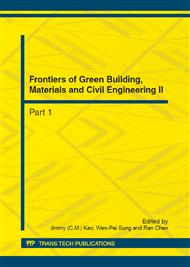p.231
p.235
p.239
p.243
p.248
p.258
p.270
p.274
p.279
Study on Development and Technology of Low-Carbon Building in Japan
Abstract:
Abstract: In the context of the global response to climate change, the construction industry with high energy consumption and high greenhouse gas emission is getting more and more attention. This paper reviews the background of low-carbon building, and studies the characteristics and trends of the low-carbon building and technological development in Japan. It analyses the low-carbon concept which applies to the building’s whole life cycle from low-carbon design concept, building constructions, building materials applications, the use of new energy resources, to the control of energy consumption and carbon emissions in Japan. Finally, considering the characteristics of the new deal about low-carbon building in Japan, this paper puts forward countermeasures and suggestions about governments and markets, industry standards, energy-saving and emission reduction, incentive and restraint mechanisms, etc. This article argues that the active behavior of government department is major factor to promote Japan’s Low-carbon building development .It expected to sum up the experience of the summarize trough Japan's the low carbon building for our government department to formulate policies and measure targeted in the low carbon architecture field.
Info:
Periodical:
Pages:
248-257
Citation:
Online since:
August 2012
Authors:
Price:
Сopyright:
© 2012 Trans Tech Publications Ltd. All Rights Reserved
Share:
Citation:


